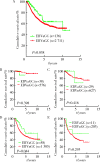[Clinicopathological and molecular characteristics of Epstein-Barr virus associated gastric cancer: a single center large sample case investigation]
- PMID: 31209416
- PMCID: PMC7439042
- DOI: 10.19723/j.issn.1671-167X.2019.03.012
[Clinicopathological and molecular characteristics of Epstein-Barr virus associated gastric cancer: a single center large sample case investigation]
Abstract
Objective: Epstein-Barr virus associated gastric cancer (EBVaGC) is different from the traditional gastric cancer (Epstein-Barr virus non-associated gastric cancer, EBVnGC), and has unique clinicopathological features. This study investigated the largest single center cancer series so as to establish the clinicopathological and molecular characteristics of EBVaGC in China.
Methods: A retrospective analysis was conducted on EBVaGC and EBVnGC patients diagnosed at Peking University Cancer Hospital from 2003 to 2018 by comparing their clinicopathological features and prognosis. The gastric cancer (GC) dataset of public database was analyzed to obtain differentially expressed genes. The expression of important genes and their association with prognosis of GC were verified in GC tissues from our hospital.
Results: In this study, 3 241 GC patients were included, and a total of 163 EBVaGC (5.0%) patients were identified. Compared with EBVnGC, EBVaGC was higher in male and younger patients, and positively associated with remnant GC, poorly differentiated adenocarcinoma, and mixed type GC. EBVaGC was inversely related to lymph node metastasis. The 5-year survival rate of EBVnGC and EBVaGC was 59.6% and 63.2% respectively (P<0.05). In order to explore molecular features of EBVaGC, the Cancer Genome Atlas (TCGA) dataset was analyzed (n=240), and 7 404 significant differentially expressed genes were obtained, involving cell proliferation, apoptosis, invasion and metastasis. The down-regulated invasion/metastasis gene SALL4 and the up-regulated immune checkpoint gene PD-L1 were important molecular features of EBVaGC. Validation of these two genes in large GC series showed that the majority of the EBVaGC was SALL4 negative (1/92, 1.1%, lower than EBVnGC, 303/1 727, 17.5%), and that PD-L1 was mostly positive in EBVaGC (81/110, 73.6%, higher than EBVnGC, 649/2 350, 27.6%). GC patients with SALL4 negative and PD-L1 positive were often associated with better prognosis.
Conclusion: EBVaGC is a unique subtype of GC with less metastasis and a good prognosis. It also has a distinct molecular background. The down-regulation of invasion/metastasis gene SALL4 and up-regulation of immune checkpoint gene PD-L1 are important molecular features.
目的: Epstein-Barr病毒相关性胃癌(Epstein-Barr virus associated gastric cancer, EBVaGC)与常见胃癌(非Epstein-Barr病毒相关性胃癌,Epstein-Barr virus non-associated gastric cancer, EBVnGC)不同,具有独特的临床病理特征,本研究采用单中心大样本探讨中国EBVaGC的临床病理及分子特征。
方法: 回顾分析2003—2018年北京大学肿瘤医院EBVaGC与EBVnGC两组患者的临床病理特征和预后。分析公共数据库胃癌数据集,筛选显著差异表达基因,并在本组病例中验证重要基因的表达及其与预后的相关性。
结果: 3 241例胃癌患者纳入研究,EBVaGC为163例,占总数的5.0%。与EBVnGC相比,EBVaGC男性常见,平均年龄低,多见于残胃癌,常为低分化腺癌、Lauren混合型,较少出现淋巴结转移,EBVaGC患者的5年生存率为63.2%,优于EBVnGC的59.6%(P<0.05)。为挖掘EBVaGC的分子特征,对癌症基因组图谱(The Cancer Genome Atlas, TCGA)胃癌数据集(n=240)进行分析,筛选到7 404个显著差异表达基因,涉及细胞增殖、凋亡、侵袭转移等功能,其中侵袭转移相关基因SALL4下调、免疫检查点相关基因PD-L1上调是EBVaGC重要的分子特征。大样本验证显示,SALL4在EBVaGC中多为阴性(1/92,1.1%,低于EBVnGC的303/1 727,17.5%),PD-L1在EBVaGC中多为阳性(81/110,73.6%,高于EBVnGC的649/2 350,27.6%),SALL4阴性和PD-L1阳性患者的预后较好。
结论: EBVaGC作为独特的胃癌亚型,较少出现转移且预后良好,该亚型具有特征性分子背景,其中侵袭转移相关基因SALL4的下调以及免疫检查点相关基因PD-L1的上调是重要的分子特征。
Figures




Similar articles
-
Clinicopathological characteristics and prognosis of Epstein-Barr virus-associated gastric cancer.Arch Virol. 2024 May 3;169(5):114. doi: 10.1007/s00705-024-06033-3. Arch Virol. 2024. PMID: 38700535
-
Expression and prognostic roles of PIK3CA, JAK2, PD-L1, and PD-L2 in Epstein-Barr virus-associated gastric carcinoma.Hum Pathol. 2016 Jul;53:25-34. doi: 10.1016/j.humpath.2016.02.007. Epub 2016 Mar 4. Hum Pathol. 2016. PMID: 26980034
-
Prognostic Perspectives of STING and PD-L1 Expression and Correlation with the Prognosis of Epstein-Barr Virus-Associated Gastric Cancers.Gut Liver. 2022 Nov 15;16(6):875-891. doi: 10.5009/gnl210359. Epub 2022 May 25. Gut Liver. 2022. PMID: 35611665 Free PMC article.
-
Epstein-Barr virus-associated gastric cancer: A distinct subtype.Cancer Lett. 2020 Dec 28;495:191-199. doi: 10.1016/j.canlet.2020.09.019. Epub 2020 Sep 23. Cancer Lett. 2020. PMID: 32979463 Review.
-
Epstein-Barr Virus-associated Gastric Cancer and Potential Mechanisms of Oncogenesis.Curr Cancer Drug Targets. 2017;17(6):534-554. doi: 10.2174/1568009616666160926124923. Curr Cancer Drug Targets. 2017. PMID: 27677953 Review.
Cited by
-
Up-Regulation of SALL4 Is Associated With Survival and Progression via Putative WNT Pathway in Gastric Cancer.Front Cell Dev Biol. 2021 Feb 11;9:600344. doi: 10.3389/fcell.2021.600344. eCollection 2021. Front Cell Dev Biol. 2021. PMID: 33644042 Free PMC article.
-
A novel nomogram for predicting survival of patients with poorly differentiated gastric adenocarcinoma.Transl Cancer Res. 2021 Feb;10(2):886-898. doi: 10.21037/tcr-20-2794. Transl Cancer Res. 2021. PMID: 35116418 Free PMC article.
-
PD-1 antibody camrelizumab for Epstein-Barr virus-positive metastatic gastric cancer: a single-arm, open-label, phase 2 trial.Am J Cancer Res. 2021 Oct 15;11(10):5006-5015. eCollection 2021. Am J Cancer Res. 2021. PMID: 34765307 Free PMC article.
-
Observational cohort study of clinical outcome in Epstein-Barr virus associated gastric cancer patients.Ther Adv Med Oncol. 2020 Jul 6;12:1758835920937434. doi: 10.1177/1758835920937434. eCollection 2020. Ther Adv Med Oncol. 2020. PMID: 32670421 Free PMC article.
References
MeSH terms
LinkOut - more resources
Full Text Sources
Medical
Research Materials
Miscellaneous
